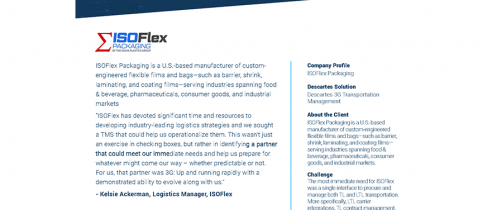Blog
How Transportation Management Systems Simplify Logistics

Logistics is big business in dollars and freight.
According to Statista, the US trucking industry revenue is $732.3 billion, and third-party logistics (3PL) revenue is $231.5 billion. In the US, trucks alone move over 64% of the country’s freight, covering over 5.25 trillion ton-miles. And it’s not slowing down.
Together with the growing logistics market, the supply chain has become increasingly complex with more moving parts and more data. Shippers, brokers, and 3PLs now face a wider array of transportation options. The supply chain management technology needed to help manage this market is no longer a value-add option. It’s a necessity in negotiating the modern supply chain.
In this post, discover how a transportation management system (TMS) simplifies today’s logical needs from automation to data management and customer service. And learn why you can’t move freight and manage logistics without it.
How the supply chain has evolved and where it stands
Advancements in supply chain technology have created both efficiencies and opportunities. But it has also created headaches for companies that must sort through the forest of fulfillment technology options.
Likewise, customer expectations have evolved to demand more visibility into the full supply chain process. They expect greater efficiency from modern logistics and continually seek premier customer service.
Regardless, today’s logistics industry faces a lot of challenges. Among the top challenges cited by Global Trade magazine are:
- Cutting transportation costs.
- Adopting new and innovative technology solutions.
- Meeting customer expectations for visibility.
- Improving cooperation with partners and suppliers.
Companies can’t meet these needs for efficiencies or customer expectations with traditional, manual logistics processes or by applying a combination of technical solutions to meet specific supply chain management needs. To keep up and stay competitive, they need a modern TMS. A cloud-based TMS coordinates and consolidates data, analytics, and reporting in one platform to simplify logistics.
How transportation management systems simplify logistics
Explore four key ways a TMS creates efficiencies and adds value across logistics functions.
1. Real-time data and deep analytics for improved decision-making
Logistics pulls data from many supply chain management functions and systems, including:
- Order management
- Route optimization
- Enterprise resource planning (ERP) systems
- Internet of things (IoT) sensors and tracking devices
- Real-time pricing updates
- Government-provided transportation industry data
The volume of this data for logistics providers can improve decision-making and create efficiencies. But they can’t achieve the full benefits of this data when it’s siloed by different technology solutions. Their data can’t provide visibility into the big picture or maximum impact.
Logistics providers can only maximize the value of their data across transportation management functions to improve decisions when it combines all internal and external sources into one centralized location. A TMS consolidates internal and external data sources, including:
- Carrier performance information
- Current pricing information
- Insurance and regulatory details
The combined data enables a TMS to improve key day-to-day logistics functions such as order, route, and load management. By improving operational efficiency through effective data handling, logistics providers save time and reduce costs. With access to the full scope of available data, a TMS can provide rich analytics into performance and other business metrics and create valuable and relevant reports.
By using consolidated data in a centralized repository, a TMS provides analytics and reporting to improve organizational efficiency, saving time and money.
To understand the value of having a central data repository from a TMS, consider the example of Mohawk Global Logistics. The company implemented a TMS with automation and analytics capabilities, eliminating the need to check rates for various carriers in multiple places. Mohawk Global has realized significant value from this incremental improvement across logistics management functions by optimizing its workflow to gain greater insights.
Between improving data access and automating analytics and reporting capabilities with a TMS, logistics providers can easily uncover business opportunities, identify cost savings areas, and improve efficiency.
2. Streamlined process automation in one central place
Traditionally, logistics management entailed many manual processes, which were full of redundancies and prone to human error, especially when transferring or reentering information between them. Technology has dramatically improved these manual methods, with task-specific software or hidden functions through other automation tools.
A TMS simplifies logistics by combining disparate capabilities under a single software umbrella to bring coordinated automation across the entire logistics operation.
With a TMS, you automate functions across fulfillment to provide organization-wide efficiencies, reduce errors, and gain visibility into the entire fulfillment process.
Carrier management
Automation with a TMS begins with carrier management. For onboarding, a TMS has the following capabilities:
- Connects to delivered at terminal (DAT), Registry Monitoring Insurance Services (RMIS), and other monitoring solutions to speed up carrier qualification.
- Provides the ability to choose the best carrier for each job based on performance data.
- Improves contract management by providing real-time visibility into contracts for terms and cost comparisons.
Order management
For order management, a TMS pulls data from systems like inventory and vendor databases and fulfillment systems. It provides visibility into orders—from placement to fulfillment—while dynamically updating order changes.
By automating order management, a TMS can:
- Generate optimized route plans.
- Manage transportation change demands.
- Coordinate customer delivery.
- Integrate delivery data into the TMS.
The result is fewer lost, delayed, or damaged orders and visibility into the order process for clients, managers, and customer service representatives.
Freight management
For freight management, a TMS:
- Collects and analyzes data to predict freight costs across orders and order types.
- Automates spot quoting by reviewing historical lane pricing and evaluating current market rate conditions across supply chain partners.
- Includes real-time visibility into shipments across the transportation network for status tracking—automating monitoring for potential issues and customer updates.
3. Improved customer service with big-picture visibility
Good customer service is key to logistics. Today’s customers expect to know what’s happening with an order from placing it to shipping and delivery. They especially want to know about delays, bottlenecks, or other issues that occur during fulfillment. Managing these situations should be seamless and error-free.
In a TMS, data handling and reporting with supply chain visibility and automation directly translates to improved customer service. With greater visibility, logistics providers can give customers real-time alerts on deliveries and delays. If a problem occurs, a TMS can communicate through system integrations with customer service representatives who can provide relevant order information to resolve issues. The TMS can also suggest solutions to streamline the process.
TMS-enabled visibility also optimizes the order-to-fulfillment cycle, improving service and providing advanced tools so providers can help their customers make better business decisions. TMS analytics and reporting generate the following key performance metric data so customers can improve their own analytics:
- Shipping cost
- Time of transit
- On-time delivery rates
- Damage rates
As a result, the TMS makes resolving customer service issues fast and painless. It also gives customers:
- Added value from key performance data providers can share.
- Reassurance by having full transparency and visibility into the entire fulfillment process.
When providers and customers have real-time visibility into the supply chain with a TMS, customer service improves by providing added reassurance and expedited problem-solving.
For Mohawk Global Logistics, data, analytics, and reporting helped improve its internal processes and drive new business. The ability to provide customers continuous visibility into orders and automated shipment reports became a selling point for the company in choosing a TMS. The TMS integration hub alone saved time and money for both Mohawk and its customers through quick onboarding of new accounts with a simple and fast setup process.
4. Comprehensive and simplified logistics
The complex modern supply chain requires technology-driven logistics. A TMS simplifies the technology puzzle by unifying key features in one place:
- Data handling, automation, and reporting.
- Optimized supply chain functions like carrier, order, and freight management.
- Streamlined customer service tools and information.
The benefits of using a comprehensive TMS to simplify logistics include:
- Reduced transportation costs because of automation across supply chain processes, better planning to optimize fulfillment, and automating delivery exception handling.
- More control over operations through centralized transportation management.
- Operational goals, such as better cargo consolidation, that aren’t achievable through manual processes, lowering costs across the fulfillment process.
- Fewer mistakes from human error because internal and external supply chain systems are integrated, saving time and money.
- Automated performance data collection, analytics, and reporting for better decision-making and added value for customers.
- Improved overall customer service, leading to increased sales.
The list goes on. The value of automating logistics for greater visibility is worth the increase in customer satisfaction achieved by greater service and fulfillment transparency.
Simplify your logistics process with a TMS
Logistics service providers must keep up with today’s fast-paced business needs to grow and stay competitive. This state of logistics requires the ability to pivot and build operational efficiencies quickly. A complicated technology stack with multiple software solutions for different process functions isn’t flexible enough to scale with changing business needs and expanding operations. A modern, cloud-based TMS simplifies logistics by becoming the central technology control point, even integrating seamlessly with niche solutions.
Explore how a modern, cloud-based TMS can streamline your shipping, brokerage, or 3PL business. Schedule a meeting.







